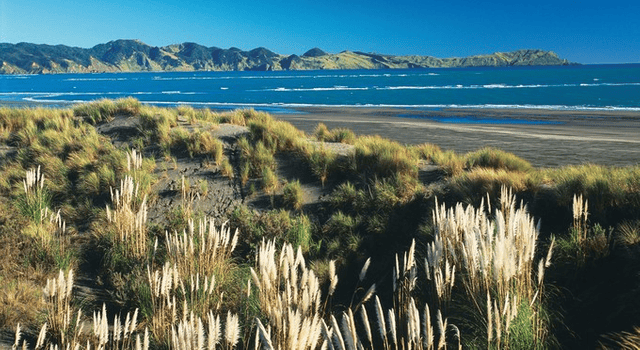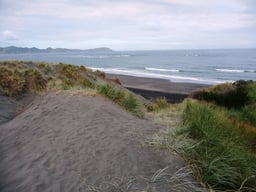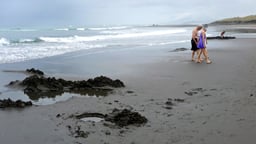Kāwhia Harbour

Kāwhia Harbour

Kawhia | |
|---|---|
| Coordinates:38°6′S 174°48′E [24] | |
| Country | |
| Region | King Country |
| Territorial authority | King Country District |
| Ward | Otorohanga |
| Electorate | Waikato |
| Government | |
| • MP | Barbara Kuriger (National) |
| • Mayor | Max Baxter |
| Population | |
| • Urban | 650 |
| Time zone | UTC+12 (NZST) |
| • Summer (DST) | UTC+13 (NZDT) |
| Postcode | 2451 |
| Area code(s) | 07 |
Kawhia Harbour (Maori: "Kāwhia") is one of three large natural inlets in the Tasman Sea coast of the Waikato region of New Zealand's North Island. It is located to the south of Raglan Harbour, Ruapuke and Aotea Harbour, 40 kilometres southwest of Hamilton. Kawhia is part of the Otorohanga District Council.[1] It has a high-tide area of 68 km2 (26 sq mi) and a low-tide area of 18 km2 (6.9 sq mi).[2]
The settlement of Kawhia is located on the northern coast of the inlet, and was an important port in early colonial New Zealand.[3] The area of Kawhia comprises 16 to 20 hectares (40 to 50 acres) and is the town block that was owned by the New Zealand Government. The government bought it from the Europeans in 1880 "not from the original Māori owners, but from the a European who claimed ownership in payment of money owed by another European".[3]
Te Motu Island is located inside the harbour.
Kawhia | |
|---|---|
| Coordinates:38°6′S 174°48′E [24] | |
| Country | |
| Region | King Country |
| Territorial authority | King Country District |
| Ward | Otorohanga |
| Electorate | Waikato |
| Government | |
| • MP | Barbara Kuriger (National) |
| • Mayor | Max Baxter |
| Population | |
| • Urban | 650 |
| Time zone | UTC+12 (NZST) |
| • Summer (DST) | UTC+13 (NZDT) |
| Postcode | 2451 |
| Area code(s) | 07 |
History and culture
Early history
Kawhia is known in Māori lore as the final resting-place of the ancestral waka (canoe) Tainui. Soon after arrival, captain Hoturoa made it first priority to establish a whare wananga (sacred school of learning) which was named Ahurei.[6] Ahurei is situated at the summit of the sacred hill behind Kawhia’s seaside marae – Maketu Marae. The harbour area was the birthplace of prominent Māori warrior chief Te Rauparaha of the Ngāti Toa tribe, who lived in the area until the 1820s, when he, and his tribe along with Ngāti Rārua and Ngāti Koata migrated southwards.
Tainui was buried at the base of Ahurei by Hoturoa himself, and other members of the iwi. Hoturoa marked out the waka with two limestone pillars which he blessed. Firstly, there is "Hani (Hani-a-te-waewae-i-kimi-atu) which is on the higher ground and marked the prow of the canoe".[7] Marking the stern of the canoe, Hoturoa placed the symbol of Puna, the spirit-goddess of that creation story. "In full it is named Puna-whakatupu-tangata, and represents female fertility, the spring or source of humanity".[6] It is said that a pure woman who touches this stone will be given the gift of a child, and become pregnant. There have been cases of women using Puna when they have had difficulty conceiving a child.
Marae
Maketu Marae is located next to Kawhia Harbour. The main meeting house of the marae, Auau ki te Rangi, is named after Hoturoa’s father who was a high chief (ariki) and was built and opened in 1962.[8]
The eldest and most prestigious meeting house that was first built on Maketu Marae is Te Ruruhi (the Old Lady) which was used as the dining hall until 1986. It was replaced by a two-storey dining hall, Te Tini O Tainui, to cater for the numerous numbers that visit for occasions such as annual poukai, tangi and hui.[9] The marae is affiliated with the Maniapoto hapū of Apakura and Hikairo, and the Waikato Tainui hapū of Ngāti Mahuta and Ngāti Te Weehi.[10]
Five other marae are also based at or near Kawhia Harbour:
Mōkai Kainga Marae and Ko Te Mōkai meeting house is a meeting place for the Maniapoto hapū of Apakura and Hikairo, and the Waikato Tainui hapū of Apakura.
Mokoroa Marae and Ngā Roimata meeting house is a meeting place for the Maniapoto hapū of Ngati Kiriwai.
Ōkapu Marae and Te Kotahitanga o Ngāti Te Weehi meeting house is a meeting place for the Waikato Tainui hapū of Ngāti Mahuta and Ngāti Te Weehi.
Te Māhoe Marae is a meeting ground for the Maniapoto hapū of Peehi, Te Kanawa, Te Urupare and Uekaha.
Waipapa Marae and Ngā Tai Whakarongorua and Takuhiahia meeting houses are a meeting place for the Maniapoto hapū of Hikairo, and the Waikato Tainui hapū of Ngāti Hikairo and Ngāti Puhiawe.[8][10]
Demographics
Kawhia's resident population has been falling recently, as shown by these census results -[11]
| Year | Population | Households | Median age | Median income | National median |
|---|---|---|---|---|---|
| 2001 | 507 | 198 | 44.1 | $12,100 | $18,500 |
| 2006 | 390 | 171 | 49.2 | $15,100 | $24,100 |
| 2013 | 339 | 153 | 53.8 | $19,200 | $27,900 |
In 2013 there were 231 unoccupied dwellings. 57.7% of the population had Māori origins (far above the 14.9% national average), 56.7% European, 3.8% Pacific and 1% Asian. 5.9% were born overseas, well below the 25.2% average for the whole country.[12]
Te Puia Hot Springs
Notable people
John Kent, European trader, 1820s–1830s
Cort and Annie Jane Schnackenberg, 1860s missionaries[18]
Carole Shepheard (born 1945), artist


